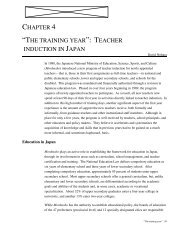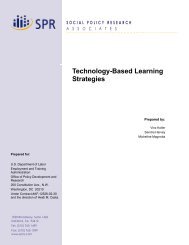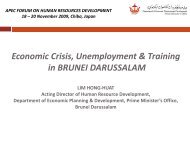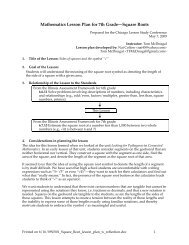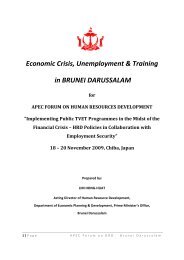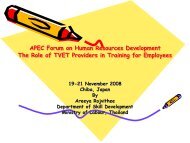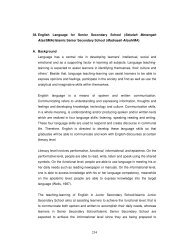Quality Assurance Systems in Asia-Pacific Economic Cooperation
Quality Assurance Systems in Asia-Pacific Economic Cooperation
Quality Assurance Systems in Asia-Pacific Economic Cooperation
Create successful ePaper yourself
Turn your PDF publications into a flip-book with our unique Google optimized e-Paper software.
ENHANCEMENT OF QUALITY ASSURANCE SYSTEMS IN HIGHER EDUCATION IN APEC MEMBER ECONOMIES<br />
that experience of the reviewers, balanced composition of the panel, presence of the agency<br />
staff <strong>in</strong> the panel, emphasis on panel consensus, emphasis on evidence-based judgement,<br />
consult<strong>in</strong>g the HEIs on the facts and emphasis of the report, etc. serve as checks and<br />
balances. AACCUP of Philipp<strong>in</strong>es <strong>in</strong>dicates that the review reports undergo a technical review<br />
before a f<strong>in</strong>al QA decision is taken based on the report.<br />
5.11 Decision-mak<strong>in</strong>g by the QA System<br />
The report or recommendation by the review team is an important <strong>in</strong>put to the quality<br />
assurance decisions of the agency. There are at least four different ways <strong>in</strong> which the APEC<br />
economies use the review team’s report/observations to take a f<strong>in</strong>al QA decision.<br />
There are systems where the f<strong>in</strong>al decision depends on the review team’s recommendation<br />
only. The assumption here is that the team has analysed all relevant <strong>in</strong>formation, and<br />
therefore its recommendation is sufficient as a basis for decision-mak<strong>in</strong>g. The QA agency<br />
only checks whether the site visit was carried out objectively, whether there is adverse<br />
feedback from the <strong>in</strong>stitutions or programs that were assessed or from the QA staff who<br />
coord<strong>in</strong>ated the visit, and if found appropriate, the recommendations of the review team<br />
become the quality assurance outcome.<br />
Some agencies consider review team’s report and self-assessment report of the <strong>in</strong>stitution or<br />
program. The assumption here is that while the external review report is an important <strong>in</strong>put,<br />
the report prepared by the <strong>in</strong>stitution is also important enough to be considered on its own by<br />
the quality assurance agency or its board.<br />
Yet another variation is that the f<strong>in</strong>al decision depends on the review team’s report, selfassessment<br />
report, and other relevant <strong>in</strong>formation. In this case, the quality assurance agency<br />
considers other relevant <strong>in</strong>formation such as general data on the <strong>in</strong>stitution or the program,<br />
other survey reports, government reports, reports of the professional bodies submission by<br />
the other stakeholders or data regard<strong>in</strong>g other <strong>in</strong>stitutions or programs, that may help put the<br />
decision <strong>in</strong> perspective.<br />
Some systems consider review team’s report, self-assessment report, other relevant<br />
<strong>in</strong>formation and <strong>in</strong>stitutional response. This is a variation of the process mentioned above<br />
where the <strong>in</strong>stitutional response receives specific consideration <strong>in</strong> the decision-mak<strong>in</strong>g<br />
process. Here the <strong>in</strong>stitutional response is more than just a feedback about the site visit and<br />
the review team. Before the decision is made, the <strong>in</strong>stitution may be asked to respond on<br />
certa<strong>in</strong> aspects which would feed <strong>in</strong>to the f<strong>in</strong>al decision mak<strong>in</strong>g. For example, as already<br />
mentioned, <strong>in</strong> the US, the HEIs appear before the regional accredit<strong>in</strong>g commissions to expla<strong>in</strong><br />
their case. Similar to the self-assessment report, the <strong>in</strong>stitutional <strong>in</strong>puts through these<br />
meet<strong>in</strong>gs are also considered while tak<strong>in</strong>g the QA decision.<br />
“Who takes the f<strong>in</strong>al quality assurance decision?” depends on the role the various parties are<br />
expected to play <strong>in</strong> the quality assurance process, e.g. whether the reviewers can only advise<br />
the agency or make judgements about the quality as discussed earlier.<br />
22



